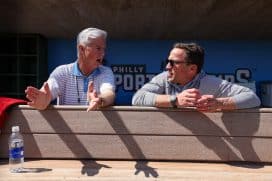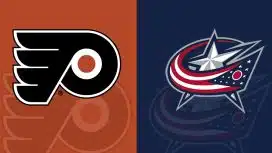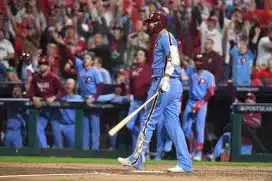Uncategorized
The Flyers and Latter-Round Drafting Philosophy
In most every NHL Draft, there players available beyond the first round who have the potential to become NHL regulars and sometimes are even destined for stardom. Drafting such players takes a lot of luck as well as scouting acumen.
However, generically speaking, the latter-round picks who tend to go on to NHL careers fit in one or more of the following broadly defined categories in their draft year:
- Skilled but undersized,
- Skilled and average pro height but narrow frame
- Skilled but deficient in skating
- Skilled but deficient in defensive play
- Two-way player with iffy hands
- Big-framed but raw power forward candidates
- Athletic but unpolished goaltenders
- European players, especially ones whom scouts fear may not be as effective in the smaller-rink game
- North American Junior A and high school players who have dominated against low levels of competition but have not been tested yet in higher-level leagues.
The 2015 Draft had an abundance of such players in the pool. By no means am I suggesting that all or even the majority of them are going to go on to become NHL players, let alone future stars. Chances are that most of them will fall short of the NHL.
No one has a crystal ball to determine which player(s) it will be that make a larger impact, which is why teams sometimes use picks in the second or third round on projected fourth-line players or role-playing defensemen. The overall odds of selecting a future NHL player from the third round onward drops to about 15 percent.
My own philosophy: I'd rather take a lower percent chance of finding a future top-six forward, top-four defenseman or starting NHL goalie in Round 3 than take even a higher-percentage chance of selecting a bottom-end of the lineup player.
Come Round 6 or 7, I'd be thrilled if my pick turned out to be an NHL player of any stature, including single-purpose role players such as the Flyers' Zac Rinaldo (who, in fact, was originally taken by the Flyers in the sixth round of the 2008 Draft).
It's when a team uses a top-100 pick on a projected fourth-liner that the selection of that player can rightfully be questioned.
For example, back in the 2007 Draft, the Flyers took Saskatoon Blades fourth-line right winger Garrett Klotz with the 66th overall pick. The reasoning behind the pick was that Klotz — who has a gargantuan 6-foot-6 frame, a penchant for physical play and a willingness to drop the gloves — someday had the chance to become a fearsome role player in the NHL. The Flyers believed that his hockey skills would eventually come along as well.
On the day following the completion of the 2007 Draft, I blogged about my own dissatisfaction with the Flyers' decision to select Klotz as early as they did. I rattled off the names of 10 still-available forwards believed to have superior potential to enforcer prospect Klotz.
Of the 10 forwards I listed in that blog as preferable alternatives to Klotz, only four have gone on to play in the NHL at all. Just one (Jamie Benn, who fit the Junior A player and the needs-to-fill-out categories back in 2007) has gone on become an NHL star. Two others (Joakim Andersson and Alex Killorn) are current NHLers. As it turned out, Klotz himself ended up being a fringe AHL player.
Keep this is mind: When it comes time to make a draft selection, NHL teams don't have luxury of rattling off numerous players they like and then claiming victory if one or two pan out. Additionally, a team may have a certain player on their radar screen for a subsequent pick but get beaten to the punch.
For example, back in 2003, Patrice Bergeron was not ranked in The Hockey News' top 100 prospects in the 2003 Draft Preview issue and it was only due to a second-half surge during the 2002-03 QMJHL season that Central Scouting even had him on their radar screen as a potential mid-round pick for the 2003 Draft.
If the draft had gone as projected — it rarely does beyond the first few picks — the Flyers would have taken him in the third round (they had five third-rounders that year but no second-rounder). Flyers scouts Simon Nolet and Dennis Patterson were both very high on Bergeron and the team, in fact, considered trying to move up into the second round specifically to take Bergeron.
Ultimately, though, it didn't matter. Boston took Bergeron in the middle of the second round (45th overall pick), which was well ahead of where most everyone else had him projected to go. This is a good case in point of why it is tough to Monday morning quarterback a draft: one never knows whom an organization has to cross off its list on the draft floor because another team got him first.
It is very easy to pick apart a team's draft years after the fact. Hindsight is always 20-20. For example, it's easy to say now that the Flyers whiffed on the second round of the 2006 Draft, when they had three picks – Andreas Nödl at 39th overall, Mike Ratchuk at 42nd and Denis Bodrov at 55th — but only one went on to play at all in NHL and none became impact players.
At the time, however, all three of the Flyers' second round picks were easily justifiable selections. They went for players who were thought to have pretty high ceilings, but
Nödl was a dynamic two-way talent at the USHL and, later, the collegiate lever St. Cloud State. His offensive game did not translate to the pro game as it turned out but seemed to have all the tools to become a solid NHLer — decent size, good skating, 200-foot-game potential.
Ratchuk was a pure offensive defenseman. There were significant defensive question marks and he lacked size but his puck skills and shot were well above average. He never developed from that point onward and ended up bouncing around the minor leagues but it was a high-risk, high-reward proposition from the start. Had he panned out, as the (even smaller but smarter and more committed) Shayne Gostisbehere has thus far done, it would have seemed like a fine pick.
Bodrov was widely projected at the time as having a similar upside to former Flyer Danny Markov. It didn't work out that way, but the Flyers were far from the only NHL team who liked him.
On the flip side, the Flyers' entire 2014 Draft crop made varying degrees of progress in their first year after the draft. Nicolas Aube-Kubel, Mark Friedman, Oskar Lindblom, Radel Fazleev and Phantoms defenseman Jesper Pettersson are all better players than they were a year ago. Thus far, at least, it seems like the Flyers could end with multiple future pros from the 2014 Draft in addition to first-round pick Travis Sanheim.
Returning to the 2015 Draft, in the middle rounds of the draft, would you take one-in-15 odds of finding a future NHLer or would you take the somewhat better odds on a lower upside player? There is a rationale for either approach. I'd personally still go for whomever I thought had the higher best-case-scenario potential rather than strictly the higher chance reaching the NHL.
This is not to discount the importance of role players on a team or to say that players taken in the first round or two who ultimately become NHL role players should be considered busts. Rather, it is because role players tend to be easier and less expensive for teams to acquire through non-Draft means than trying to fill out the top of the roster that way.
Bill Meltzer is a columnist for Flyerdelphia. Follow him on Twitter @billmeltzer.












































